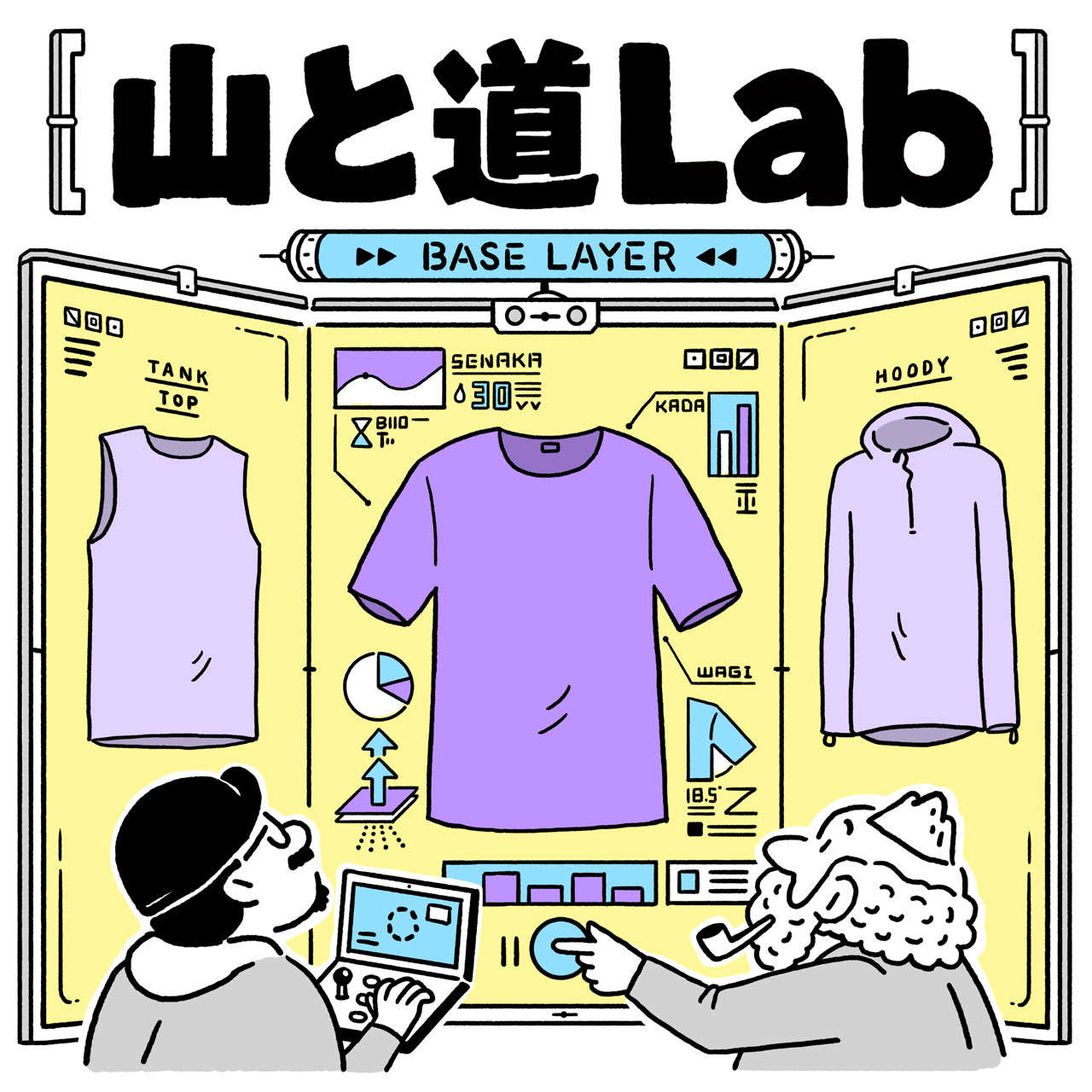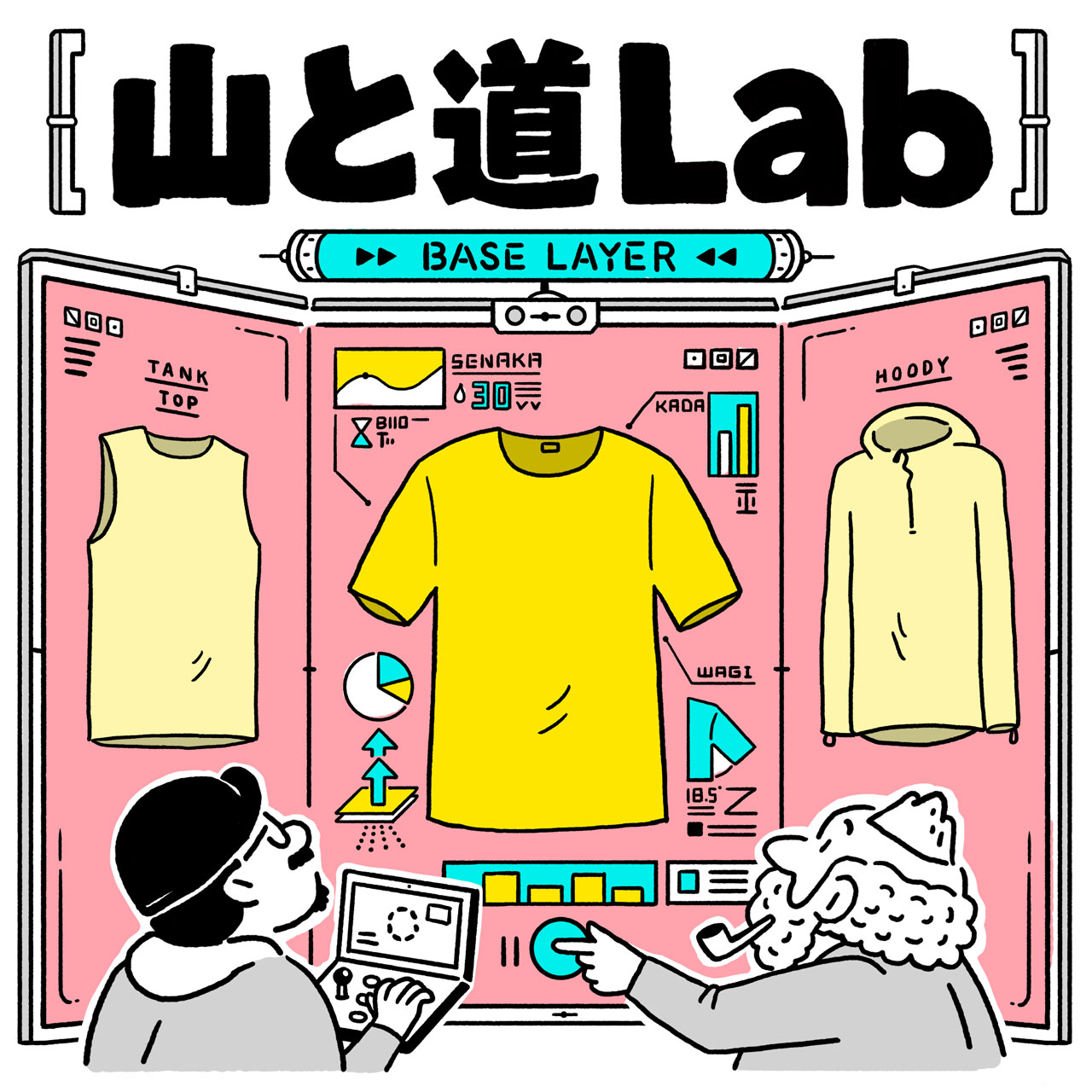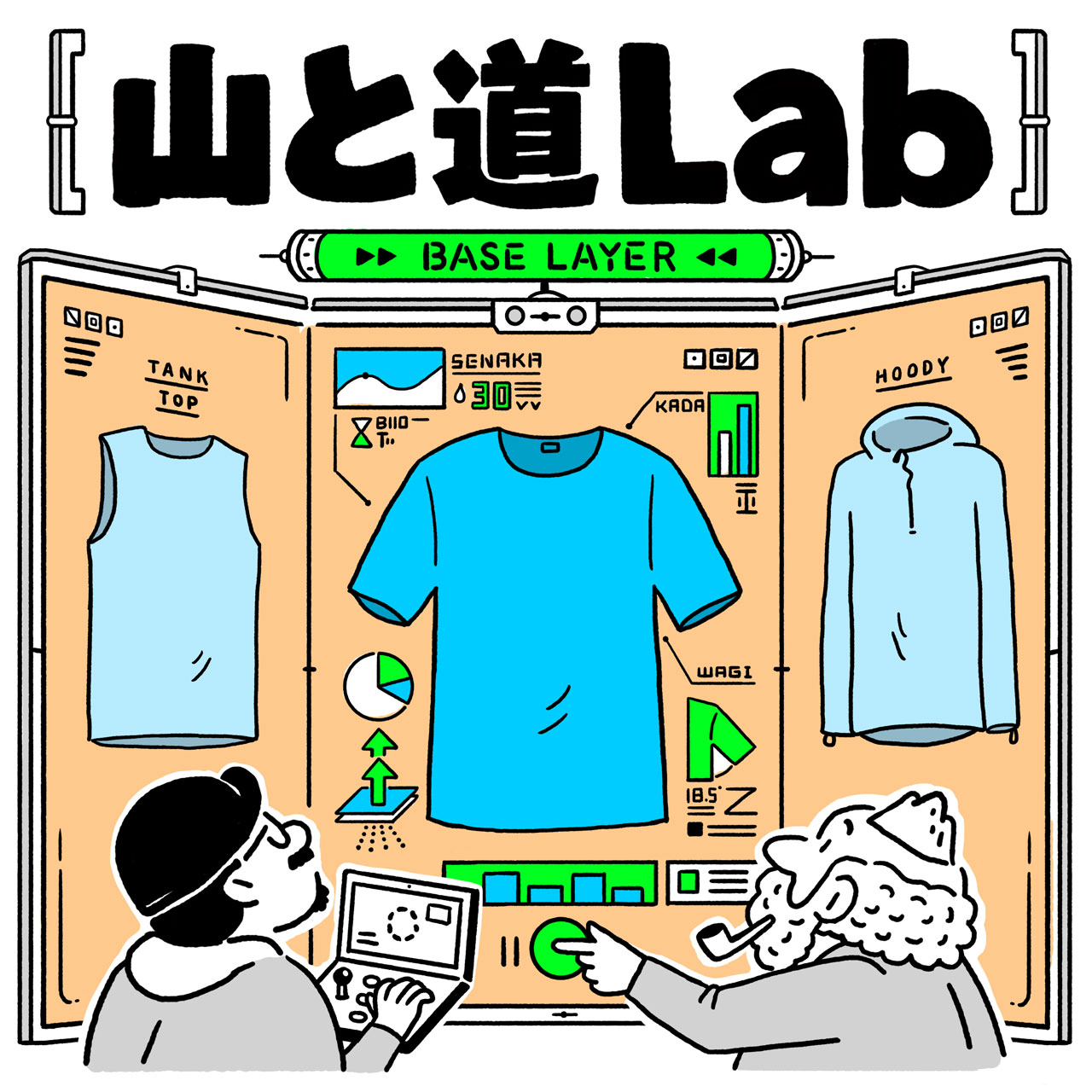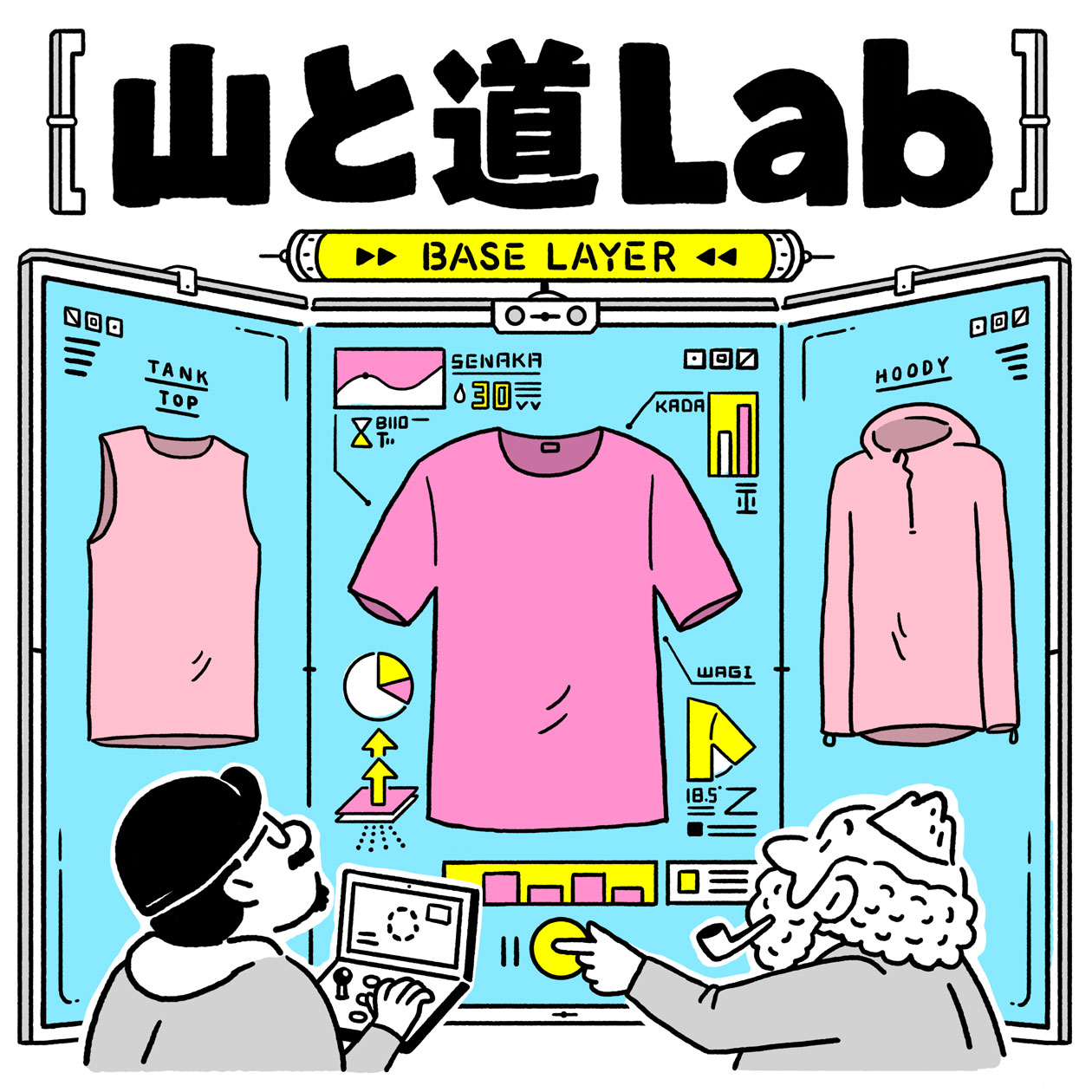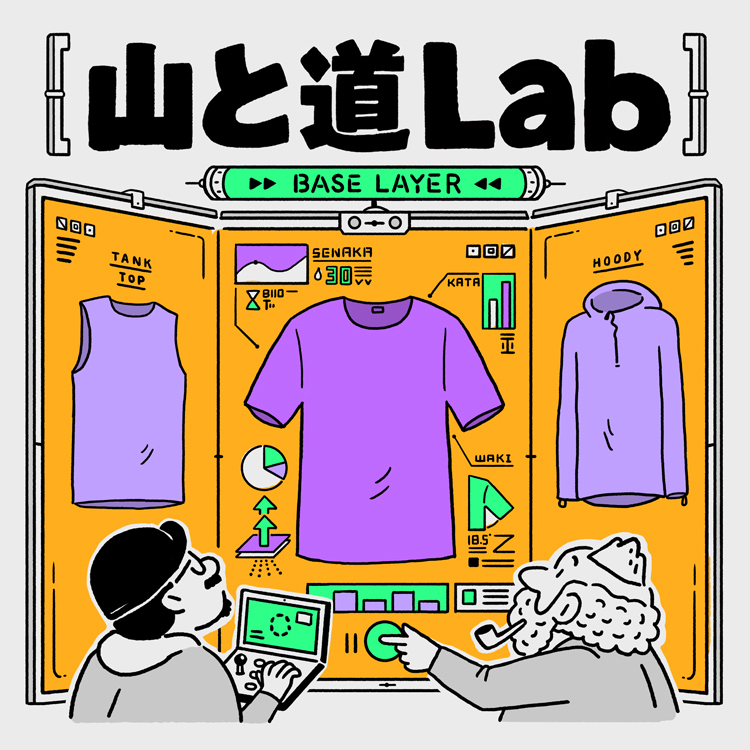Introducing Chemical B: Yamatomichi’s New Synthetic Base Layer
Co-developed with Teijin Frontier, the Chemical B Series overcomes two long-standing problems of synthetic base layers: sweat chill and odor.
Its knit structure absorbs and dries sweat quickly to reduce chill, while slightly acidic yarn helps prevent the growth of odor-causing bacteria. The result is a synthetic base layer that delivers the comfort of merino with the durability and quick-drying performance of synthetics.
A base layer for those who’ve avoided synthetics until now—designed for hikers who move fast in the mountains.
 UNISEXRESTOCK ALERT
UNISEXRESTOCK ALERT MENRESTOCK ALERT
MENRESTOCK ALERT WOMENRESTOCK ALERT
WOMENRESTOCK ALERT
Features
- Excellent moisture management for lasting comfort, even during long, high-intensity activity
- Outstanding odor resistance, despite being synthetic
- Lighter than merino wool
- Durable against pilling, even with its thin mesh fabric
Product story
Why did we make a synthetic base layer?
After years devoted to merino wool, why take on the challenge of creating a synthetic base layer?
To explore that question, I launched a year-long experiment called Yamatomichi Lab: Base Layer Edition (2019–2020). The aim was to better understand what makes a base layer truly perform. At the same time, I wanted to put merino wool through rigorous testing, confirm its strengths, and find a clearer way to share its unique appeal.
(Currently only available in Japanese)
Through countless comparative tests, we confirmed merino’s strengths—its odor resistance, temperature control, and moisture regulation. But I also came to appreciate what synthetics offer, especially their breathability and quick-drying performance.
From there, a new idea began to take shape:
- A synthetic base layer that resists odor like wool
- Yet is lighter and more durable, addressing wool’s weaknesses
This became the starting point of the project.
We found that odor control and insulation are especially important for hiking, while moisture-wicking, dispersing, and quick-drying properties are crucial for trail running.
We also identified two main approaches to managing sweat effectively:
Ventilation type — uses lightweight fabrics with mesh or grid structures to maximize breathability and speed up evaporation.
Wicking type — pulls sweat quickly away from the skin, spreads it across the fabric surface, and keeps the inside dry.
In other words, an excellent base layer needs three things: odor control, insulation (which doesn’t necessarily mean warmth), and superior sweat management. Of these, sweat management is the critical factor for both hiking and trail running.
The first two years of development were slow. As someone deeply attached to merino wool, I found it difficult to discover a synthetic material I truly wanted to wear while hiking.
Things changed once we began working with Teijin Frontier. Their trial fabrics treated with EcoPure®—a yarn treatment that suppresses odor-causing bacteria—showed impressive odor-eliminating performance. That discovery gave the project real momentum and accelerated development.
With EcoPure® providing reliable odor control, we concluded that the wicking approach—keeping the skin consistently dry—delivers greater comfort. Mesh fabrics work well for hot-weather trail running, but we found them less effective in cases of heavy sweating or in Japan’s hot, humid climate, where drying simply can’t keep up.
We tested countless prototypes. The first hurdle was odor control, followed by sweat management, and then durability.
As a brand that has long championed the strengths of merino wool, Yamatomichi could not settle for a half-hearted synthetic base layer. Our goal was to create one that hikers would actively choose even over merino. With that conviction, we pressed forward with development.
After overcoming each challenge, the final step was validation. Because sweat and body odor differ from person to person, a meaningful test required a diverse group of users. For this prototype, we involved 14 participants—including staff and partners—the largest test group we had ever assembled.
The research that began with Yamatomichi Lab: Base Layer Edition finally came together after five years in the form of Chemical B.
Feedback was largely positive, but it also revealed how differently people perceive odor control. Some felt Chemical B’s deodorizing effect was very strong, while others noticed it less.
To explore this, we measured the acidity and alkalinity of over 100 sweat samples using litmus paper, yet no clear pattern emerged.
What we did learn is that Chemical B is particularly effective at suppressing the ammonia odor that occurs immediately after exercise. However, it is less effective against acidic odor compounds such as butyric acid and isovaleric acid, which are commonly associated with body odor. Since sweat composition and body chemistry vary from person to person, this likely explains the range of experiences—a mystery we are eager to continue investigating.

At Takeda no Mori, December 2023 — my first and last trail running race (Photo: Ryo Hirano)
No matter how much data or how many test results we collect, what truly matters is how a product feels when you put it on and start moving.
For me, the real value of Chemical B isn’t only its odor control, but the comfort of its sweat management. Even when damp, it doesn’t cling to the skin or cause discomfort—and in this respect, I believe it even surpasses merino wool. On hot, demanding days, Chemical B is the base layer I instinctively reach for.
Review
During development, 14 staff and friends tested prototypes and shared their feedback. Here, we highlight impressions from long journeys such as thru-hikes and endurance races.

On more demanding mountain days, I’d wear nothing else.
I think this might be Yamatomichi’s first product with a truly race-oriented style. In terms of lightness, quick-drying, and packability, it holds its own against products marketed by other brands for running and trail running—and honestly, I’d rather choose this one. I also use Yamatomichi’s 100% Light Merino for running, but for higher-output hikes and runs, I’d switch entirely to Chemical B.
I wore the Chemical B Sleeveless for long distances during the 2024 TJAR (Trans Japan Alps Race), and it was all I needed. Even after the race, the fabric showed no damage, fraying, or noticeable pilling. Since the fabric has limited stretch, I personally find it more comfortable to size up for better mobility.

TJAR 2024 competitor
Nicknamed “Popcorn,” Daisuke is an indoorsy type who loves anime, manga, and games. He’d rather not leave the house, but hiking helps him just barely avoid becoming a full-on shut-in. After years of moving around overseas for work, he gained weight and started running to lose it (and to enjoy good beer). Before he knew it, he had completed five traverses across Japan. He still hates running, and rebound weight gain is his constant companion.

22 days straight on the trail
I wore the Chemical B Sleeveless on a 600 km thru-hike across Iceland—and didn’t take it off for 22 days straight. Carrying 20 days’ worth of food and full camping gear, this single base layer stayed on day and night, for both hiking and sleeping.
Back in Japan, I decided to keep going and ended up wearing it for 30 days without a single change. By the very end there was some odor, but never that sharp, unpleasant “synthetic smell.” In fact, many days I caught myself thinking, “Wait—maybe it doesn’t smell at all?” Personal impressions aside, one thing was clear: even over long-term use, Chemical B showed outstanding odor resistance.
It also resisted chill after sweating, never felt sticky even when soaked, and unlike merino wool, I didn’t have to worry about abrasion.
For someone who used to choose only merino wool for base layers, Chemical B gave me a completely new option.

Yamatomichi Kamakura Staff
Originally from Osaka, Oji relocated to Kamakura in 2017. After working as a book planner and editor at an art-related publishing company he went freelance and now also works at our Yamatomichi Zaimokuza shop while running his own book business. He is also a keen gardener and hunter!

Makes you wonder when the smell will come.
It doesn’t match merino completely, but compared to any synthetic I’ve worn, the difference was remarkable. Even with my heavy sweating, the fabric never felt soaked, heavy, or clammy—and it didn’t have that plasticky synthetic feel.
I wore it day and night for 14 days in the Swiss Alps (17–25°C during the day, 5–10°C at night) without a change. I sweated heavily every day, but odor didn’t appear until day 7, limited to the lower back where the pack pressed. The front and underarms stayed fresh the whole time, and even by day 13, only the back smelled enough to wash.
For a long trail, having one shirt that lasts is amazing. No changes, no laundry—just simple, comfortable days. With a base layer this odor-resistant, quick-drying, and comfortable, it’s the one I’d keep reaching for.

Yamatomichi Kyoto Staff
Ayana loved traveling since her student days and embarked on backpacking trips in search of nature. She developed a passion for hiking during these travels and began hiking while working as a nurse. She decided to quit her job to embark on overseas trekking adventures, exploring trails like the John Muir Trail in the US and trekking in Patagonia, Chile, Canada and South America. Through these adventures she was able to rediscover the beauty of Japanese mountains. After returning home, Ayana joined Yamatomichi as a staff in our Kyoto store. She enjoys trail running and is grateful for every minute spent in the mountains.

Beyond what you’d expect from synthetic
Last summer, I wore Chemical B on a thru-hike from sea level on the Japan Sea, across the Northern Alps, finishing at the summit of Mt. Fuji.
Even after a full week without changing, odor was never an issue—I simply thought, “Amazing for a synthetic!” The quick-drying performance was also a big plus: on a long journey, I could wash it, hang it up, and it would be dry in no time. Merino wool is often praised for not feeling cold when wet, but in reality it still clings to the skin and draws down body temperature. Chemical B, on the other hand, stayed off the skin even when damp, and dried so quickly that I felt completely at ease.
After reaching Mt. Fuji, I continued straight onto the Michinoku Coastal Trail. Since that trail connects mountains with towns, there are many points where you drop down into villages. Thanks to Chemical B’s excellent odor resistance, I could step into town with confidence, even after days on the trail.

Yamatomichi Kyoto Staff
Originally captivated by the allure of traveling abroad, a chance encounter during a trip ignited Daisuke’s passion for outdoor culture. This led to unforgettable experiences, including canoe touring in Canada and trekking in Alaska. Driven by a desire for longer, more immersive adventures, Daisuke tackled the Pacific Crest Trail (PCT) in North America in 2022, followed by the Continental Divide Trail (CDT) and Spain’s Camino de Santiago in 2023. Inspired by the ultralight hiking culture he encountered along the way, he joined Yamatomichi, eager to share these experiences with others. Always in pursuit of “a journey that feels true to himself,” he continues to explore and refine new styles of travel.
Product voice
The story behind Chemical B
The Chemical B Series is a base layer designed to eliminate sweat discomfort and odor while offering comfort, lightness, and durability. By combining the strengths of synthetics and merino wool, it achieves performance at a level we had long been striving for.
In this two-part video series—Overview and Behind the Scenes—Yamatomichi founder Akira Natsume and researcher Takahiro Watanabe share Chemical B’s features and performance, as well as the five-plus years of trial and error that went into its development.
Material
A proprietary Yamatomichi fabric that combines Teijin Frontier’s antibacterial pH-control material, Type EP—designed to maintain a mildly acidic balance—with their high-performance knit, DELTAPEAK™. The result is a breathable, sweat-resistant mesh with a point-contact structure.
The point-contact design lifts the fabric slightly from the skin, reducing cling and enhancing comfort. At the same time, the knit quickly absorbs sweat, spreads it across the surface, and releases it through the mesh for rapid evaporation. This combination of breathability and quick-drying performance keeps skin dry, comfortable, and free from stickiness.
By preventing moisture from returning to the skin, it also avoids the clammy chill typical of synthetic base layers, helping you stay comfortable even during breaks or in bad weather.

295kPa:Off White
*The above data is based on our in-house test results (measured values, not guaranteed values).
*Values shown are averages for each color (individual differences may exist within the same color).
Type EP by Teijin Frontier
With pH control technology, the fabric surface resists becoming alkaline, an environment in which odor-causing bacteria tend to thrive, and instead stays in a mildly acidic state that supports freshness. The fibers also become hydrophilic, allowing dirt to wash out more easily and preventing sebum buildup, which helps keep the product clean and easy to care for. Tests show that Type EP remains effective even after 100 washes*.
*Based on Yamatomichi’s in-house test results
DELTAPEAK™ by Teijin Frontier
A knitted fabric made from densely woven yarns with fine crimp (waviness), achieving an exceptionally smooth surface structure. The soft, highly stretchable material resists pilling and snagging while combining excellent absorbency with fast-drying performance. Despite being lightweight, the fabric is not see-through and also provides UV protection.

Cross Section (Image courtesy of Teijin Frontier co., Ltd)


















